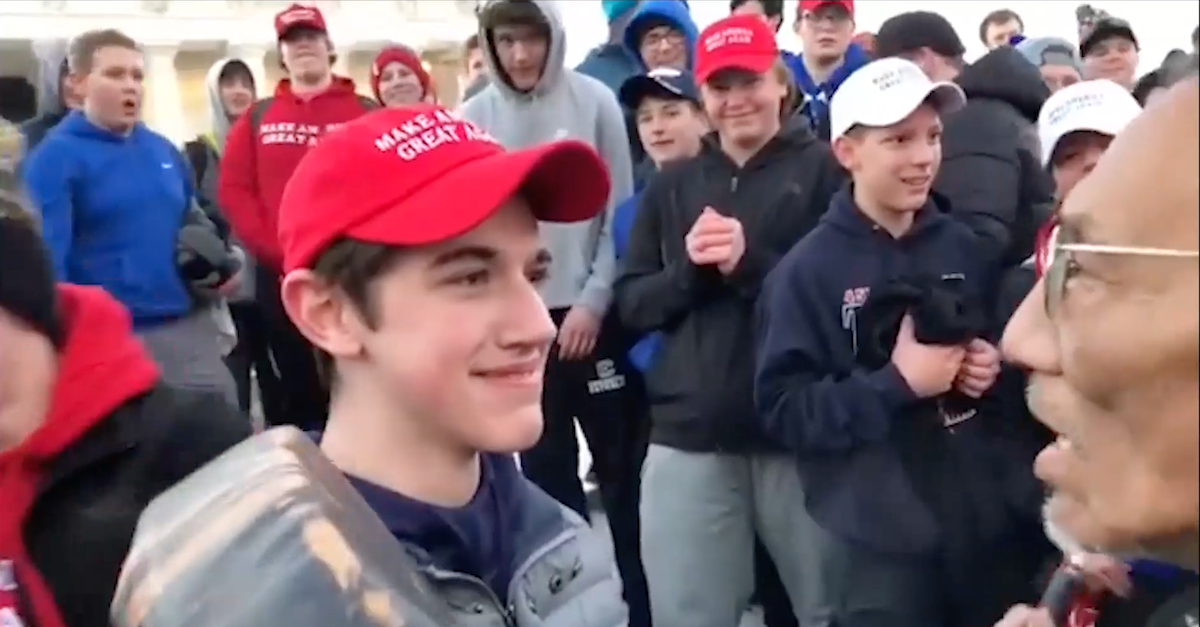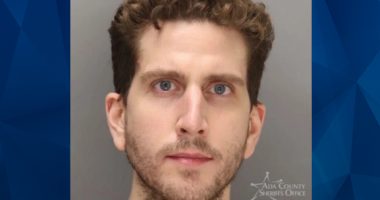
Nick Sandmann, who at the time was a Covington Catholic student, appears in a screengrab taken from a video filed as an exhibit in federal court.
A federal appellate panel in a 2-1 decision Wednesday denied former Covington Catholic student Nick Sandmann’s bid to revive libel claims against mainstream media outlets over their coverage of his 2019 encounter with Native American activist Nathan Phillips in Washington, D.C. at the March for Life.
In July 2022, Senior U.S. District Judge William O. Bertelsman, a Jimmy Carter appointee sitting in the Eastern District of Kentucky, granted summary judgment and threw out Sandmann’s lawsuit, concluding that the media outlets which covered Sandmann and Phillips’ face-to-face were “covering a matter of great public interest, and they reported Phillips’s first-person view of what he experienced” — that Sandmann had “blocked [his] way and wouldn’t allow me to retreat.”
The district judge found that “in the factual context of this case, Phillips’s ‘blocking’ statements are protected opinions.” Sandmann appealed.
U.S. Circuit Judges Jane Branstetter Stranch and Stephanie Dawkins Davis, respectively appointed to the appellate court by Barack Obama and Joe Biden, formed the majority, and Stranch penned the opinion rejecting that appeal.
The appellate majority agreed with Bertelsman’s analysis that Phillips’ “blocking” statements to the Washington Post, which were repeated by The New York Times, CBS News, ABC News, and Gannett publications, are “nonactionable” opinion:
The opinion-versus-fact inquiry thus typically involves two steps under Kentucky law. First, the court determines whether a statement is fact or opinion. If the statement is factual, the analysis ends there; the statement is considered capable of defamatory meaning. But if the statement is one of opinion, the court then determines whether that opinion is based on undisclosed defamatory facts. If so, the statement is capable of defamatory meaning; if not, it is protected opinion. Here, the district court held that the blocking statements “did not imply the existence of any nondisclosed defamatory facts,” and Sandmann does not challenge that aspect of its holding. So, if the blocking statements are opinion, they are protected by the Constitution and by Kentucky law.
The majority concluded that Phillips “expressed his subjective understanding of the situation and of Sandmann’s intent, an understanding informed by the pair’s proximity, the other students’ movement, and the lack of communication during the encounter.”
In addition, the media stories Sandmann sued over “provided multiple versions and descriptions of the events, putting a reasonable reader on notice that Phillips’s statements were merely one perspective among many.”
The majority reiterated that point while issuing a brief response to the dissent in the concluding lines of the opinion.
“Phillips’s statements are opinion, not fact. In making this finding, we are not engaging in speculation or reading improper inferences into Phillips’s statements, as the dissent suggests,” the opinion said. “Rather, we are engaging in the task required of us: a legal interpretation of Phillips’s statements in their context within the News Organizations’ articles. The statements’ opinion-versus-fact status is ‘not a question for the jury.””
U.S. Circuit Judge Richard Allen Griffin, a George W. Bush appointee, penned the lone dissent, which was as lengthy as the majority opinion.
In Griffin’s view, Sandmann’s case raised “classic claims of defamation.”
Read Related Also: Teen suspect in fatal stabbing of dancer O'Shae Sibley while he was vogueing to a Beyoncé song at Brooklyn gas station is charged with murder
“Through their news reporting, defendants portrayed plaintiff Nicholas Sandmann as a racist against Native Americans. Their characterization of Nicholas was vicious, widespread, and false,” Griffin wrote. “Defendants’ common narrative was readily accepted and effective to the extent that, on national television, NBC’s Today Show host Savannah Guthrie asked the 16-year-old if he thought he ‘owe[d] anybody an apology’ for his actions and if he saw his ‘own fault in any way.’”
Griffin said that the “truth” of the matter was demonstrated in “eighteen stipulated videos of the incident.”
Those videos “unequivocally show that 16-year-old Nicholas Sandmann did nothing more than stand still and smile while confronted by a stranger,” Griffin wrote.
Griffin did not agree that Sandmann’s case is not fit for a jury to decide.
“These cases should be submitted to a jury to decide the factual issue of whether each defendant exercised reasonable care in its reporting. I disagree that summary judgment is appropriate,” Griffin wrote. “In this regard, the majority opinion affirms the summary judgment granted in favor of all defendants, not on the basis that their reporting was substantially true or that plaintiff was a public figure necessitating a claim of malice, but on the ground that all the news articles were opinion, not fact.”
“I disagree and would reverse and remand for further proceedings,” he continued, elaborating on why:
[T]he statements that Sandmann blocked Nathan Phillips’s ascension to the Lincoln Memorial; prevented Phillips from retreating; and impeded Phillips’s movements by stepping to his left and stepping to his right, were actions capable of objective verification. Thus, because these events can be objectively verified, I would hold that the opinion exception to the laws of defamation does not apply.
Griffin later criticized the majority for engaging in “creative journalism” by essentially “rewrit[ing]” the news articles at issue:
Rather than construing the text of these statements with their plain meaning, the majority rewrites these news articles as if defendants had reported that Phillips perceived that Sandmann intended to block his way, intended to prevent his retreat, and intended to slide to his left and right. The majority’s creative journalism is apparently based on its inference that defendants meant to report that Phillips was recounting his perceptions of Sandmann’s intentions.
Law&Crime reached out to Sandmann’s attorney Todd McMurtry for comment on the ruling.
Read the opinion and dissent here.
Have a tip we should know? [email protected]







